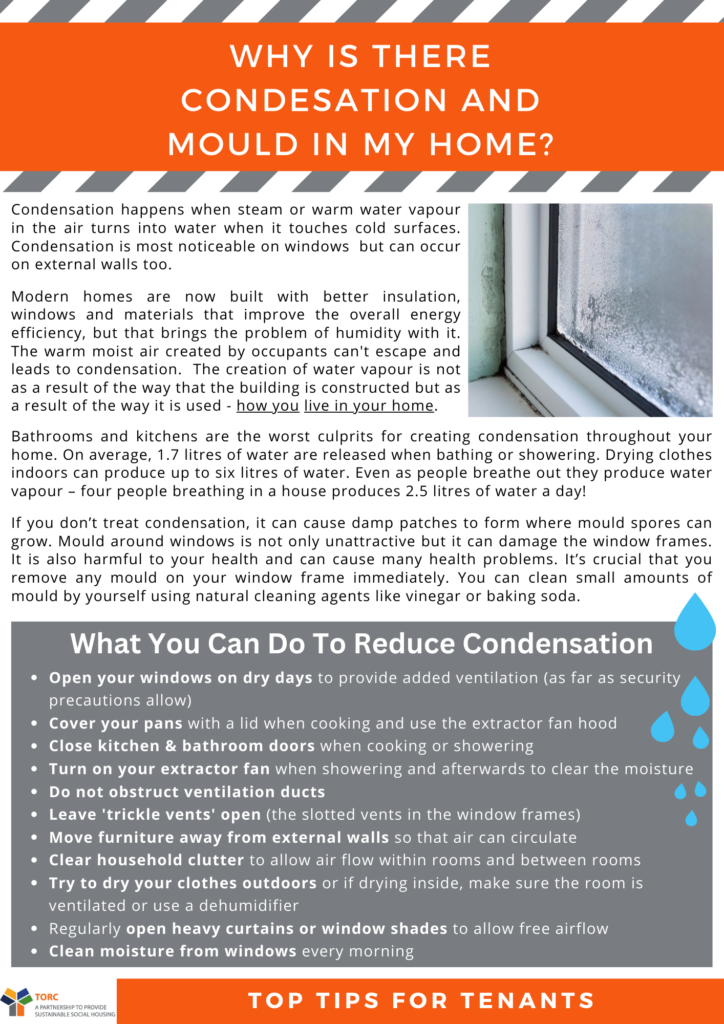TORC Top Tip for Tenants: Condensation
Condensation affects a large proportion of households in Ireland, particularly during the cold Winter months. While it is mostly harmless, if your windows aren’t maintained, the moisture could develop into dangerous mould that can cause health issues like asthma, eczema and bronchitis. If you have noticed condensation on your windows – try this month’s Top Tips to combat it.
You could purchase a Hygrometer (humidity thermometer) which will tell you if your home is too ‘wet’. For Example: ThermoPro TP50 Digital Room Thermometer/ Hygrometer. A ‘Window Vacuum’ (a motorized Suction-Squeegee) can also be used to remove condensation and excess water from windows and other surfaces like showers and mirror.
Lifestyle
More than a third of all households (37%) report they have condensation issues. Condensation happens when steam or warm water vapour floating in the air turns into water when it touches cold surfaces. Condensation is most noticeable on windows and mirrors but can occur on external walls too.
Modern homes are built much ‘tighter’ than in the past, with better insulation, windows and materials that improve the overall energy efficiency, but that brings the problem of humidity with it. The generation of water vapour that leads to condensation occurring is not as a result of the way that the building is constructed but as a result of the way it is used – how you live in your home.
Where Does Condensation Come From?
Bathrooms and kitchens are the worst culprits for creating condensation throughout your home. When cooking food, boiling the kettle, or taking a bath or shower, ensure that your kitchen or bathroom door is kept closed to prevent the moisture in the air from going into colder rooms which will cause condensation to form if it touches a cold surface. On average, 1.7 litres of water are released when bathing or showering.
Drying clothes indoors can produce up to six litres of water. Even as people breathe out they produce water vapour – four people breathing in a house produces 2.5 litres of water a day!
Mould
If you don’t treat condensation, it can cause damp patches to form where mould spores can grow. Mould around windows is not only unattractive but it can damage the window frames. It is also harmful to your health and can cause many health problems. It’s crucial that you remove any mould on your window frame immediately. You can clean small amounts of mould on windowsills or other places like the shower by yourself using natural cleaning agents like vinegar, baking soda, or tea tree oil.
Top Tips on Controling Condensation in Your Home
- Do not allow areas of damp to go untreated
- Heat and ventilate your house or apartment
- Open your windows on dry days to provide added ventilation (as far as security precautions allow)
- Cover your pans with a lid when cooking to reduce moisture being created from the water boiling
- Close Kitchen & Bathroom Doors
- Turn on Your Extractor Fan When Using Your Shower
- Do not obstruct ventilation ducts
- Leave trickle vents (slotted vents in the window frames) open
- Move Furniture Away from External Walls- so that air can circulate around the room
- Clear household clutter to allow air flow within rooms and between rooms
- Try to dry your clothes outdoors or if drying inside, make sure the room is ventilated or use a dehumidifyer
- If you have heavy drapes or window shades, try opening them up to allow free airflow.
- clean moisture from windows every morning



